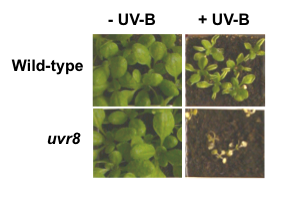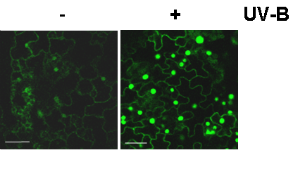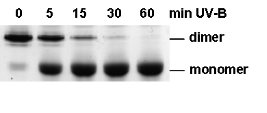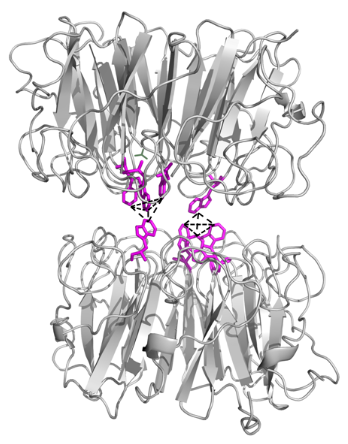The plant UV-B photoreceptor UVR8
UVR8 (UV RESISTANCE LOCUS8) is a photoreceptor specifically for UV-B light that regulates the expression of genes that promote survival in sunlight. The Arabidopsis uvr8 mutant has reduced levels of UV-protective compounds and is highly sensitive to UV-B. By comparing transcriptome profiles of wild-type and uvr8 mutant plants we found that UVR8 regulates a set of genes with key roles in UV-protection and the repair of UV damage (Brown et al., 2005). For instance, the mutant fails to induce genes concerned with production of UV-absorbing flavonoids, including the gene encoding the first enzyme in the flavonoid biosynthesis pathway, chalcone synthase (CHS), and genes encoding DNA photolyases that repair damaged DNA.

Arabidopsis uvr8 plants are highly sensitive to UV-B. Plants grown without UV-B were either left untreated (-) or exposed to a relatively high level of UV-B for 36 hours (+) and then left to recover before being photographed. UV-B slows the growth of the wild-type but kills the mutant (see Brown et al., 2005)
We found that UVR8 regulates expression of the gene encoding the HY5 transcription factor specifically in response to UV-B (Brown et al., 2005). Transcriptome analysis and studies of the expression of several UVR8-regulated genes indicate that HY5, sometimes acting redundantly with the related HYH transcription factor, controls expression of many UVR8-regulated genes (Brown and Jenkins, 2008). The hy5 mutant is very sensitive to UV-B indicating that HY5 has a key role in UV-protection.
UVR8 interacts with chromatin via histones (Brown et al., 2005; Cloix and Jenkins, 2008). There is evidence that UVR8 associates with chromatin containing the HY5 gene and several other genes it regulates, raising the possibility that UVR8 promotes the recruitment or activation of transcription factors and other proteins that facilitate transcriptional regulation. However, this aspect of UVR8 function is poorly understood.
UVR8 is present in both the cytoplasm and nucleus and brief exposure to low levels of UV-B promotes the nuclear accumulation of UVR8 (Kaiserli and Jenkins, 2007). Although the presence of UVR8 in the nucleus is required to regulate target genes it is not sufficient, as UV-B exposure is required for UVR8 function in the nucleus (Kaiserli and Jenkins, 2007).

UV-B exposure stimulates accumulation of UVR8 in the cell nucleus. Plants expressing UVR8 fused to green fluorescent protein were exposed to UV-B and examined by confocal fluorescence microscopy (see Kaiserli and Jenkins, 2007)
UVR8 is a 7-bladed β-propeller protein (Kliebenstein et al., 2002). The protein exists as a homo-dimer in plant cells but it rapidly dissociates into monomers following exposure to UV-B (Rizzini et al., 2011). The protein interacts directly with the CONSTITUTIVELY PHOTOMORPHOGENIC 1 (COP1) protein (Favory et al., 2009), which functions with UVR8 to regulate transcriptional responses. This interaction involves a 27-amino acid region towards the C-terminus of UVR8 and deletion of this region prevents UVR8 function in plants (Cloix et al., 2012). Following photoreception the UVR8 monomer reverts to its dimeric form, hence regenerating the functional photoreceptor (Heilmann and Jenkins, 2012).

Exposure of purified UVR8 to UV-B causes conversion of the protein from a dimer to a monomer. The protein is resolved by SDS-PAGE with non-boiled samples (see Christie et al., 2012)
Determination of the crystal structure of the purified UVR8 protein has provided information on its mechanism of photoreception (Christie et al., 2012; Wu et al., 2012). The dimer is maintained by salt-bridge interactions between charged amino acids at the dimeric interface. Mutation of specific charged amino acids makes UVR8 constitutively monomeric. We found that UVR8 employs specific tryptophan amino acids as its chromophores for UV-B photoreception. These tryptophans are present at the dimeric interface in a pyramid arrangement spanning the dimer and are adjacent to salt-bridging amino acids. Our hypothesis is that UV-B photoreception causes neutralization of salt-bridges leading to monomerisation. Mutation of the chromophore tryptophans impairs UVR8 function in plants (O’Hara and Jenkins, 2012). We are presently undertaking further research to understand the mechanisms of UVR8 photoreception and signal transduction.

Structure of the UV-B photoreceptor UVR8 showing the pyramid arrangement of UV-B-sensing trytophans across the dimeric interface. Photoreception causes disruption of salt bridges that hold the dimer together, leading to monomerisation and hence signalling (see Christie et al., 2012)
Molecular basis of plant responses to the environment
UV-B and protection against pest attack

